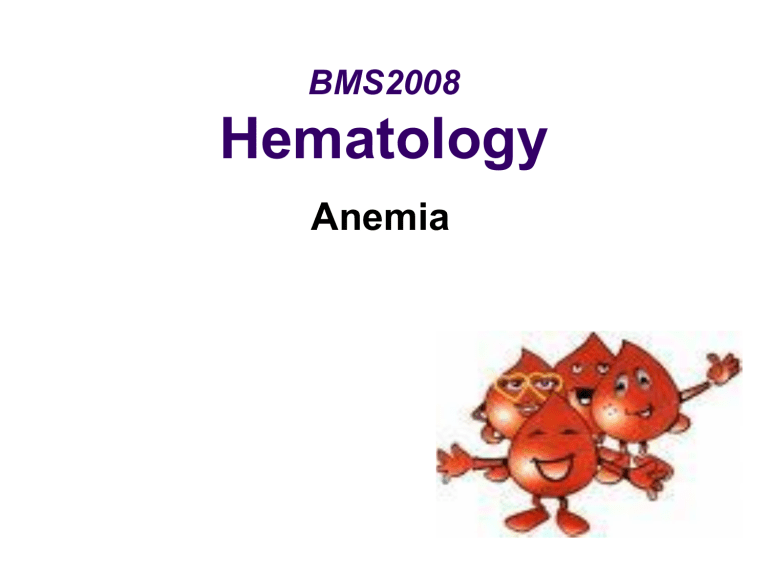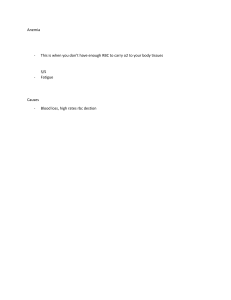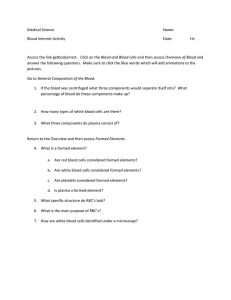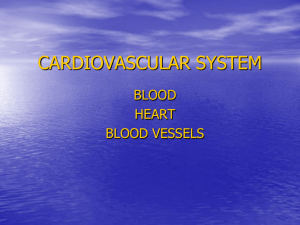
BMS2008 Hematology Anemia Erythrocyte Destruction • Breakdown of the RBC ▫ Toward the end of 120 day life span of the RBC, it begins to break down. - The membrane becomes less flexible. - The concentration of cellular hemoglobin increases. - Enzyme activity, especially glycolysis, diminishes Removal ▫ Aging RBC’s or senescent RBC’s are removed from the circulation by the reticuloendothelial system (RES) which is a system of fixed macrophages. These cells are located all over the body, but those in the spleen are the most efficient at removing old RBC’s. Erythrocyte Destruction • Two Paths • Extravascular • Intravascular • About 90 % of RBC destruction is extravascular. • Extravascular destruction occurs in the macrophages of the spleen, liver and bone marrow. • Extravascular destruction is the most efficient method of cell removal. • The remaining 10% occurs intravascularly, where the RBCs lyse and release their hemoglobin into the bloodstream. Extravascular Destruction • Hostile surrounding in the spleen, stress the RBC • Glycolysis slows, ATP production ends • Intracellular sodium increases, potassium decreases allowing water to enter the cell • Water enter the cell- RBCs loose flexibility • RBC’s are now trapped in spleen Extravascular Destruction • The RES cells lyse the RBC’s and digest them. Components of the RBC are recycled. ▫ Amino acids from globin are recycled into new globin chains ▫ Iron is transported by transferrin to the bone marrow to be recycled into hemoglobin or stored in the macrophage ▫ The protoporphyrin ring from heme is broken and converted into biliverdin ▫ Biliverdin is converted to unconjugated bilirubin and carried to the liver by albumin, a plasma protein. ▫ Bilirubin is conjugated in the liver and excreted into the intestine, where intestinal flora convert it to urobilinogen. ▫ Most urobilinogen is excreted in the stool, but some is picked up by the blood and excreted in the urine. ▫ Conjugated (direct) and unconjugated (indirect) bilirubin can be used to monitor hemolysis. Intravascular Destruction ▫ ▫ ▫ ▫ The free hemoglobin α and β dimers that are released into the bloodstream is picked up by a protein carrier called haptoglobin. The haptoglobin-hemoglobin complex is large and cannot be excreted in the urine. It is carried to the liver where the RES cells are and the breakdown process occurs as in extravascular destruction. If there is an increase in intravascular destruction, the haptoglobin is used up and free hemoglobin is excreted in the urine (hemoglobinuria). Hemopexin is another plasma protein that assists in salvaging iron. Anemia Anemia ● ● ● Anemia is the inability of the blood to supply the tissue with adequate oxygen for proper metabolic function. Clinically, anemia is defined as a decrease in the normal concentration of hemoglobin or erythrocytes. Anemia is not a disease, but an expression of an underlying disorder or disease. Development of Anemia ● Anemia occurs if: ● ● Erythrocyte loss or destruction exceeds the maximum capacity of bone marrow erythrocyte production OR Bone marrow erythrocyte production is impaired or abnormal Causes of anemia ● Acute blood loss (hemorrhage) ● Accelerated destruction of RBC’s (immune or non● ● ● ● ● ● immune) Nutritional deficiency (iron, folate or B12) Bone marrow replacement (e.g. cancer) Infection Toxicity Hematopoietic stem cell arrest or damage Hereditary or acquired defect Erythropoiesis: Production and maturation of erythrocytes in the bone marrow Rubriblast Pronormoblast Proerythroblast Rubricyte Reticulocyte Polychromatic normoblast Diffusely basophilic erythrocyte Polychromatic erythroblast Polychromatophilic erythrocyte Prorubricyte Metarubricyte Mature RBC Basophilic normoblast Orthochromatic normoblast Erythrocyte Basophilic erythroblast Orthochromatic erythroblast Discocyte 11 Anemia Classifications ● Functional ● Uses absolute and corrected reticulocyte count, Reticulocyte production index (RPI, also called a corrected reticulocyte count), and serum iron for classification ● The normal reticulocyte count ranges between 0.5 % to 2.5% in adults and 2% to 6% in infants ● Types ▪ Survival Defects (Increased Destruction) ▪ Proliferation Defects (Decreased production) ▪ Maturation Defects Anemia Classifications ● Morphologic ● Uses erythrocyte indices (MCV) for classification ● Types ▪ Macrocytic (size: Larger) / Normochromic (color: Normal) ▪ Causes: Folate or B12 deficiency, liver disease, alcoholism ▪ Normocytic / Normochromic ▪ Causes: bone marrow failure, hemolytic anemia, chronic renal failure, leukemia, metastatic malignancy ▪ Microcytic / Hypochromic (paler than normal) ▪ ▪ Most common anemia Causes: iron deficiency, sideroblastic anemia, thalassemia, chronic diseases Reticulocyte production index Megaloblastic anemia: A form of macrocytic anemia, a blood disorder that happens when your bone marrow produces stem cells that make abnormally large red blood cells. Myelodysplasia: A group of cancers in which immature blood cells in the bone marrow do not mature or become healthy blood cells. Aplastic anemia: A condition that occurs when your body stops producing enough new blood cells. Thalassemia: An inherited blood disorder that causes your body to have less hemoglobin than normal. Sideroblastic anemia: A type of anemia that results from abnormal utilization of iron during erythropoiesis. Diagnosis of anemia ● ● ● Clinical history Physical signs such as paleness, fatigue, weakness and shortness of breath Laboratory tests ● ● ● ● ● ● ● CBC (complete blood count) Examination of the blood smear Reticulocyte - measures effective erythropoiesis Bone marrow examination Iron studies - iron, total iron-binding capacity (TIBC), ferritin Vitamin B12 and folate Erythropoietin level Laboratory Tests for Measurement of Anemia Hemoglobin ● Reference values ▪ ▪ ● Moderate anemia: ● ● Male: 14-17.4 g/dl Female: 12-16 g/dl 7-10 g/dl Severe anemia: ● <7 g/dl Hematocrit ● Reference values ● ● Male: 42-52% Female: 36-46% Parameters of the CBC (complete blood count) ● ● ● Red Blood Count or RBC Hemoglobin: grams per deciliter (g/dl) Hematocrit : the volume percentage of red blood cells in blood ● ● Note: the approximate relationship of the hemoglobin to the hematocrit is 1:3. This may vary with the cause of the anemia and the effect on the RBC indices, especially the MCV. RBC indices ● MCV - (mean corpuscular volume) Average red blood cell size, mean cell volume ● ● ● ● Normal:80-100 fL (femtoliters: 10−15 litres) Derived from RBC histogram OR calculate Used to classify RBCs as normocytic, microcytic or macrocytic Indicates the average volume of the red cells Calculation: Hct % x 10 RBC count (millions/mm3) RBC Indices con’t ● MCH (mean corpuscular or mean cell hemoglobin) -Hemoglobin amount per red blood cell, mean cell hemoglobin weight ● ● ● Normal: 28-34 pg A measurement of the hemoglobin content in RBC’s Calculation: Hgb x 10 RBC MCHC (mean corpuscular hemoglobin concentration) - The amount of hemoglobin relative to the size of the cell (hemoglobin concentration) per red blood cell, mean cell hemoglobin concentration ● Normal: 32-36 % ● Used to classify RBCs as normochromic, or hypochromic ● A measure of the concentration of hemoglobin in the average RBC Calculation: Hgb x 100 Hct Parameters of the CBC (complete blood count) ● When the population of RBCs varies in size, the MCV is a less reliable tool to describe the erythrocyte population. ● Therefore, the RDW or red cell distribution width is usedRDW -Red Cell Distribution Width ● Calculated index used to identify anisocytosis, a condition when the red blood cells are unequal in size ● Normal: 11.5-14.5% Calculation: Standard deviation of MCV x100 Mean MCV Reticulocyte ● ● ● ● Adult reference range: 0.5 - 2.5% Useful in determining the response to the anemia and the potential of the bone marrow to manufacture RBC’s. Expressed as a percentage of the RBC’s. When anemia is present, it is helpful to correct the retic using the patient’s hematocrit in order to assess appropriate bone marrow response A supravital stain called New Methylene Blue is used to stain reticulocytes. On a Wright’s stained smear, reticulocytes appear as bluish red cells. The term used for retics on Wright’s stain is polychromasia. Corrected retic% = reticulocyte % X Patient hct Normal hct* based on age and sex [*Normal female hct = 42%] [*Normal male hct = 45%] Reticulocyte ● ● ● Prematurely released reticulocyte remain in the blood and take from ½ to 1 ½ days longer to mature. This will cause even the “corrected” reticulocyte to be elevated, so a calculation must be performed to correct for this situation to obtain the reticulocyte production index (RPI). A maturation time table is used for this calculation. Indicator of the adequacy of the bone marrow response in anemia ● ● RPI>2: good bone marrow response RPI<2: inadequate response RPI = corrected reticulocyte Maturation time in days Adult Reference Ranges Red Blood Cells Male: 4.5-5.5 x 106 /µl Female: 4.0-5.0 x 106 /µl Hemoglobin Male: 14-17.4 g/dl Female: 12-16 g/dl Hematocrit Male: 42-52% Female: 36-46% MCV 80-100 fL MCH 28-34 pg MCHC 32-36 % Reticulocyte 0.5-2.5% RDW 11.5-14.5% The “Normal” RBC ● Biconcave disc ● Area of central pallor ● Approx. size 7 µm RBC Size Variations ● Alterations in the size of the RBC is called anisocytosis. ● Correlate with MCV and RDW 25 Normocytic ● MCV (mean corpuscular volume) 80-100 fL Macrocytes ● 8 μm or larger in diameter ● MCV of greater than 100 fL ● Evaluate macrocytic cells for: ◦ shape (round versus oval) ◦ color (red versus blue) ◦ pallor (if present) ◦ Pallor is a condition in which a person's skin and mucous membranes turn lighter than they usually are. 27 Macrocytes ● Macrocytes arrive in peripheral circulation by three main ways: ◦ Impaired DNA synthesis leading to decreased number of cellular divisions, resulting in a larger cell ⚫Vitamin B12/Folate deficiency ◦ Accelerated erythropoiesis ending in a premature release of reticulocytes ◦ Conditions in which membrane cholesterol and lecithin are increased ⚫obstructive liver disease 28 29 Microcytes ● Diameter less than 7 μm ● MCV less than 80 fL. ● Any defect impairing hemoglobin, heme, or globin synthesis results in microcytic, hypochromic RBCs. ● Decrease in hemoglobin synthesis results in increased cellular division and, consequently, small cells. 30 Microcyte 31 RBC Color Variations ● Correlates with MCHC (mean corpuscular hemoglobin concentration) ● Reference range for MCHC= 32-36% 32 Normochromic ● Normal hemoglobin content ● MCHC 32-36 % Hypochromia ● Any RBC having area of central pallor greater than 3 μm. ● Direct relationship between amount of hemoglobin in red cell and appearance of red cell when stained. ● Any problem with hemoglobin synthesis results in some degree of hypochromia. 34 Hypochromia ● ● MCHC <32 Most frequently seen in iron deficiency anemia. See in thalassemias, hemoglobinopathies, and sideroblastic anemias. May also see hypochromia in lead poisoning. 35 Hypochromia Grading 36 Polychromasia ● Occurs when immature RBCs are released into peripheral blood stream. ● Blue-gray in color ● Larger than normal RBCs ● Basophilia is a result of residual RNA fragments involved in hemoglobin synthesis. 37 Polychromasia ● Cells are actually reticulocytes. ● Common to find a few polychromatic cells on a normal peripheral blood smear. ● Reticulocyte count should reflect the degree of polychromasia present. 38 Polychromasia ● Causes of: ◦ ◦ ◦ ◦ acute and chronic hemorrhage hemolysis regenerative red cell process newborns ● Excellent indicator of therapeutic effectiveness for correcting iron deficiency anemia or vitamin therapy. 39 Polychromasia Grading 40 Hyperchromasia ● Does not exist!!!!!! Although we can have cells with a MCHC greater than 36%, we generally do not use the term hyperchromasia as a descriptive term. 41 RBC Shape Variations ● Alterations in the shape of the RBC is called poikilocytosis. 42 Target Cells (Codocytes) ● Occur due to an increased red blood cell surface area. ● Appear as "targets" on peripheral blood smear. ● Have a pale central area with most of the hemoglobin around the rim of the cell. ● Are always hypochromic. 43 Target Cells (Codocytes) ● Mechanism in formation is related to excess membrane cholesterol and phospholipid, and to decreased cellular hemoglobin. ● Osmotic fragility is decreased. 44 So what is Osmotic Fragility? ● It is a test to measure RBC resistance to hemolysis ● The quicker the hemolysis occurs, the greater the osmotic fragility ● What affects osmotic fragility? ◦ Surface to volume ratio ◦ Cell membrane permeability Target Cells (Codocytes) ● Seen in patients with: ◦ ◦ ◦ ◦ ◦ ◦ Liver disease Hemoglobin C Disease or Trait Post-splenectomy Iron Deficiency Anemia Any Hemoglobin Abnormality Can be artifactual 46 Spherocytes ● Have a low surface-to-volume ratio. ● Smaller than normal red cell; hemoglobin relatively concentrated; and, have no area of central pallor. ● Shape change is irreversible. 47 Spherocytes ● Several mechanisms for formation, but all involve loss of membrane; aging, antibody coating or genetic defect ● Is the final stage for red cells before they are sequestered in the spleen. 48 Spherocytes ● Seen ◦ ◦ ◦ ◦ in patients with: Activated complement Immune Hemolytic Anemia Hereditary Spherocytosis Post-Transfusion 49 Wait! What is Complement? ● Complement refers to a complex set of 14 distinct serum proteins that are involved in three separate pathways of activation. ● Major Functions ◦ Promote the inflammatory response by opsonization which enhances susceptibility of coated cells to phagocytosis. ◦ Alter biological membranes to cause direct cell lysis. Ovalocytes and Elliptocytes ● Ovalocytes may appear normochromic or hypochromic; normocytic or microcytic. ● Hemoglobin concentrated at both ends ● Exact mechanism of formation unknown. 51 Ovalocytes and Elliptocytes ● Ovalocytes associated with: ◦ Myelodysplastic Syndromes ◦ Thalassemias ◦ Megaloblastic Processes ● Elliptocytes associated with: ◦ Iron Deficiency Anemia ◦ Hereditary Elliptocytosis ◦ Idiopathic Myelofibrosis 52 Stomatocytes ● Red cell of normal size ● Slit-like central area of pallor ● Exact mechanism of formation unknown ● Usually artifactual ● Increased osmotic fragility 53 Stomatocytes ● Associated with following disorders: ◦ Hereditary Stomatocytosis ◦ Hemolytic, Acute Alcoholism ◦ Rh Null Phenotype 54 Sickle Cells (Drepanocytes) ● Sickle cells are known by a variety of names. They can be called drepanocytes, cresent cells, oat cells or boat cells. ● Have at least one pointed end. ● Surface area of cell much greater than normal cell. 55 Sickle Cells (Drepanocytes) ● ● Low oxygen tension causes hemoglobin to polymerize, forming tubules that line up in bundles to deform cell. Most sickle cells can revert back to normal shape when oxygenated. 56 Sickle Cells (Drepanocytes) ● Associated with the following disorders: ◦ Sickle Cell Anemia ◦ Hemoglobin C Disease 57 Acanthocytes ● Acanthocytes are also ● ● ● ● ● known as thorn cells or spur cells. Normal or slightly smaller size Possess 3-12 thorny projections of uneven length along periphery of cell membrane. Projections are blunt Acanthocytes lack an area of central pallor. Acanthocytes appear saturated with hemoglobin, but the MCHC is normal. 58 Acanthocytes ● Specific mechanism of formation unknown. ● Contain increased cholesterol-to-phospholipid ratio. ● Surface area increased ● Susceptible to removal by spleen 59 Acanthocytes ● Possible pathologies include: ◦ ◦ ◦ ◦ ◦ Alcohol Intoxication Pyruvate Kinase Deficiency Congenital Abetalipoproteinemia Vitamin E Deficiency Post-Splenectomy 60 Fragmented Cells ● Includes: ◦ Burr Cells ◦ Helmet Cells ◦ Schistocytes ● Fragmentation is defined as a loss of a piece of cell membrane that may or may not contain hemoglobin. ● The shapes of these cells varies based on shear forces and the presence of fibrin strands in the circulation. 61 Fragmented Cells Two pathways that lead to fragmentation: ● ◦ ◦ Alteration of normal fluid circulation (vasculitis, malignant hypertension, heart valve replacement). Intrinsic defects of red cell that make it less deformable (spherocytes and antibody-covered red cells). 62 Burr Cells (Echinocytes) ● Red cells with 10-30 evenly spaced spicules over the surface of the cell. ● Normocytic and normochromic. ● In large numbers, are an artifact of sample contamination. 63 Burr Cells (Echinocytes) ● "True" burr cells occur in small numbers in uremia, heart disease, stomach cancer, bleeding peptic ulcers, and in patients with untreated hypothyroidism. ● Seen in liver disease, renal disease, and burn patients. ● May occur in any situation that causes change in tonicity of intravascular fluid (dehydration). 64 Helmet Cells (Bite Cells) ● Helmet cells or bite cells are another type of fragmented cell that has distinctive projections surrounding an empty area of the RBC membrane. ● Usually have two projections surrounding an empty area of red cell membrane. ● Looks as if cell has had a bite taken out of it. ● Caused by spleenic pitting and impalement of the RBC on fibrin strands 65 Helmet Cells (Bite Cells) ● In conditions where red cells have large inclusion bodies (such as Heinz bodies ● G6PD deficiency ● May be seen in patients with pulmonary emboli, and disseminated intravascular coagulation (DIC) 66 Schistocytes ● Schistocytes are another type ● ● ● ● ● of fragmented cell. Extreme cell fragmentation Cell is missing whole pieces of membrane. Schistocytes are split or cut indicating there has been some sort of trauma to the cell membrane. Schisotocytes can appear triangular or comma shaped. Causes bizarre shapes of red cells. 67 Schistocytes ● Caused by loss of membrane by mechanical means ● See in patients with microangiopathic hemolytic anemia, DIC, heart valve surgery, or severe burns. 68 Teardrop Cells ● Appear as pear-shaped cells. ● Length of tail varies. May be microcytic, macrocytic. ● Exact normocytic, formation unknown. or process ● Commonly seen in red cells that contain large inclusion bodies. ● There is a correlation with cells that have inclusions and the rate of teardrop formation. ● As these cells with inclusions attempt to pass through circulation, the parts of cells holding the inclusion not get through and the gets pinched, leaving a end. the the can cell tail 69 Teardrop Cells ● Most commonly seen in idiopathic myelofibrosis, thalassemia, and iron deficiency anemia. 70 Agglutination ● Irregular clumps of RBCs from antigen-antibody reactions ● See in cold hemagglutinin disease and paroxysmal nocturnal hemoglobinuria(PNH) ● Reported as “RBC agglutination noted” 71 Agglutination ● Use of saline will not disperse clumps; however, warming specimen helps to break clumps up. ● On a patient that demonstrates cold agglutinins, the MCHC will be falsely elevated. elevated. ● The best way to resolve agglutination is to warm the specimen to 370 C to disperse the clumps. 72 Rouleaux ● Appears as a stack of coins ● Use of saline disperses formation of stacks ● Correlates well with elevated sedimentation rate. 73 Rouleaux ● Caused by increased or abnormal plasma proteins ● Result of protein deposits on the erythrocyte membrane ● Seen in patients with multiple myeloma, Waldenstrom's macroglobulinemia, and chronic inflammatory disease. 74 Howell-Jolly Bodies ● Howell-Jolly bodies are dark ● ● ● ● purple or violet spherical granules in the erythrocyte. Are nuclear remnants containing DNA. Are 1-2um in size and appear singly around periphery of red cell membrane. They appear singly around the edge of the RBC membrane. Develop during periods of accelerated or abnormal erythropoiesis. 75 Howell-Jolly Bodies ● Spleen usually removes them; however, during times of erythroid stress, spleen cannot keep up with formation of inclusions and increased amounts are found in the peripheral blood. ● Seen following splenectomy, in thalassemia, hemolytic anemias, and in megaloblastic anemias. 76 Basophilic Stippling ● Cells exhibiting basophilic stippling have bluish-black granular inclusions throughout the entire cell. The granules can vary from fine to coarse in appearance. ● Contain aggregated ribosomes ● Stippling may be the result of the RBCs drying on the blood smear. ● May be seen in lead poisoning, defective or accelerated heme synthesis and thalassemia. 77 Basophilic Stippling ● May be classified as three forms: ◦ Diffuse or fine - looks like fine blue dusting. ◦ Coarse - dots are larger and more easily defined. ◦ Punctate - coalescing of smaller forms. Very prominent and easily defined. Siderotic Granules and Pappenheimer Bodies ● Pappenheimer ● ● ● ● bodies granules are that clusters of contain iron. These inclusions are often referred as siderotic granules since they contain iron. These inclusions are found at the edge of the RBC. Siderotic granules are small, irregular, magenta inclusions seen along the periphery of the cell membrane. Appear in clusters. Prussian blue stain required for confirmation Cabot Rings ● Found in heavily stippled cells ● Appear in figure-eight configuration ● Causes of: ◦ Megaloblastic anemias ◦ Homozygous thalassemias ◦ Post-splenectomy. Sideroblasts/Siderocytes ● ● ● Sideroblasts are nucleated erythrocyte that has stainable iron granules Siderocytes are ◦ Non-nucleated erythrocyte containing iron granules Must use Prussian blue stain to identify Siderocyte Siderotic Granules and Pappenheimer Bodies ● When Pappenheimer bodies are observed in Wright’s stain, they are called Pappenheimer bodies. ● When these cells are observed using an iron stain, they are referred to siderotic granules. ● Causes of: ◦ Sideroblastic anemias ◦ Any condition leading to hemochromatosis. ◦ Hemoglobinopathies ◦ Post-splenectomy patients. Heinz Bodies ● Formed as result of denaturation or precipitation of hemoglobin. ● Heinz bodies are large inclusions found at the edge of the cell. ● They are rigid and severely distort cell. ● Supravital stains used to visualize ◦ I.E. Crystal violet, ◦ brillant cresyl blue Heinz Bodies ● Causes of: ◦ Alpha thalassemias ◦ Glucose-6phosphate deficiency (G6PD) ◦ Any of unstable hemoglobin syndromes. ◦ Red cell injury from chemicals. 85


